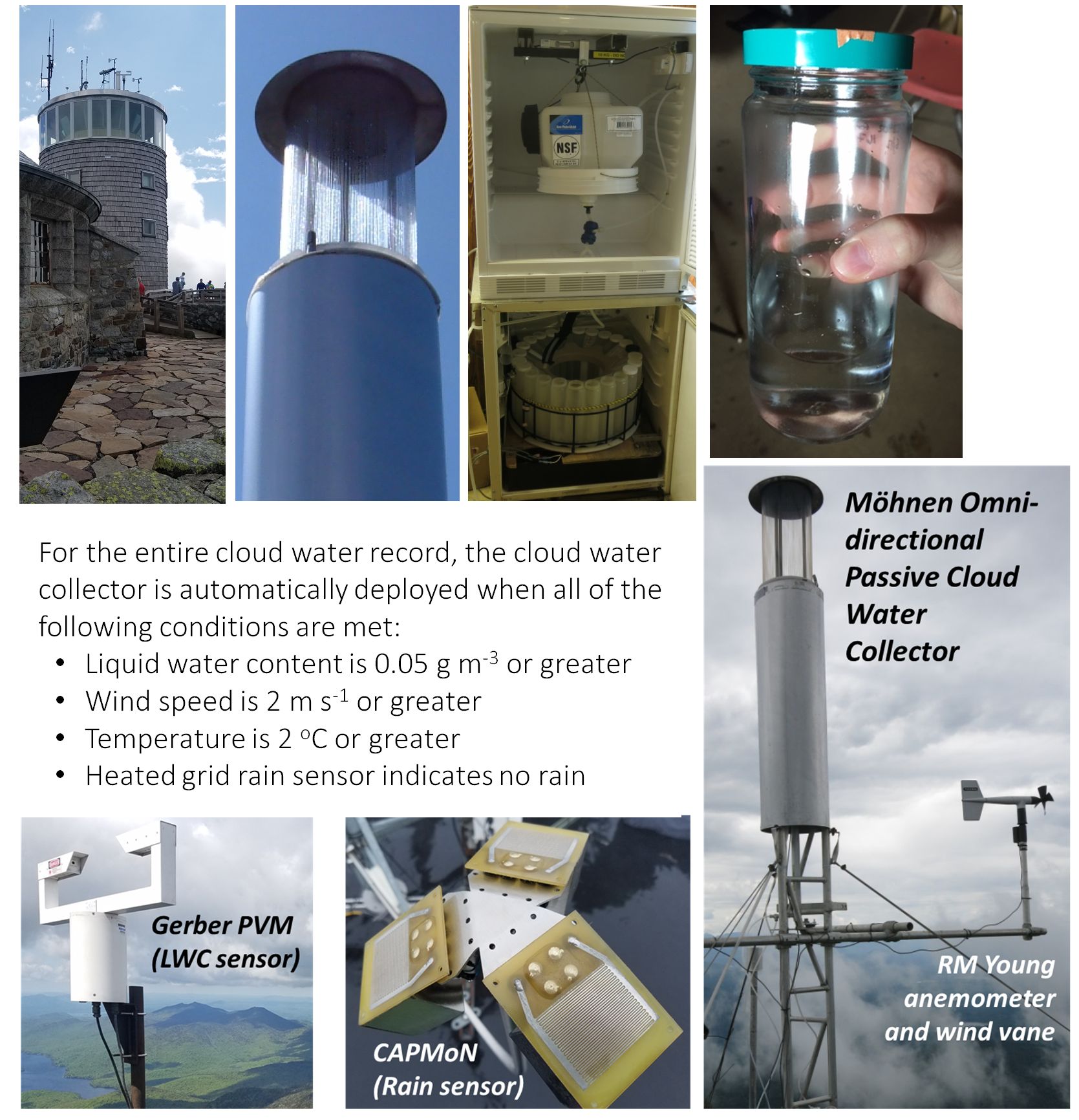Whiteface Mountain (WFM) Cloud Water Chemistry
Current Research Activities
Atmospheric pollution can have significant impacts on human and ecosystem health, visibility and climate. Cloud water plays an important role in the transformation of atmospheric pollutants, by removing particles from the atmosphere via wet deposition and by supporting aqueous chemical reactions. Long-term monitoring of cloud water composition provides a continuous view of the
Aerosol-Cloud-Interactions
While clouds clean the atmosphere by removing aerosol particles via rain and snow, clouds can also impart mass to pre-existing aerosol particles by acting as aqueous phase micro-reactors. Aerosols, in turn, control cloud microphysical properties, which can affect whether, when and where rain falls. Thus, aerosols and clouds are inextricably linked, and one cannot be fully understood without the other. Since aerosols can cycle through clouds many times throughout their atmospheric lifetime, there are many opportunities for clouds and aerosols to interact.
Past research at WFM has focused on chemical reactions leading to acid rain formation, which led to crucial emission control strategies targeting point source emissions of sulfur and nitrogen oxides. Clouds play an important role in converting these gas phase pollutants to condensed phase pollutants (within cloud droplets and aerosol particles). Researchers are now beginning to recognize that clouds can also play an important role in the formation of secondary organic aerosol mass. Organic compounds are a much more difficult class of compounds to predict and control than inorganic compounds, due in part to the mix of anthropogenic and biogenic contributions, the wide range of chemical transformations organics can undertake when exposed to oxidizing pollutants like ozone or hydroxyl radical, and the wide range of conditions (relative humidity, liquid water content and temperature) that aerosol and cloud particles are exposed to in the atmosphere. In spite of their complexities, organics cannot be neglected, as they are a dominant aerosol component. Even while nitrate and sulfate aerosol loadings have dramatically decreased at WFM over the past 25 years (see History), organic aerosol mass loadings have increased (Schwab et al., 2016).
Ongoing research at WFM has begun to focus on the organic component of cloud water. In 2009, researchers at ALSC recognized that organics were becoming more and more important and began to measure the Water Soluble Organic Carbon (WSOC) content in the cloud water. Carbon forms the backbone of organic molecules, so WSOC provides a fundamental measure of the potential contribution of organics to aerosol and cloud water mass loadings. In addition to continuing the longterm measurements of WSOC and inorganic ions, ASRC has addded organic acids to the list of analytes that are now routinely measured in cloud water collected at WFM (starting in summer of 2018).
Additional ongoing NSF funded research focuses on cloud chemical processing within clouds by sampling cloud droplet residuals (the particles left behind after cloud droplets evaporating) and comparing their chemical composition with the cloud water composition.
Recently Published Papers relating to the Whiteface Mountain cloud water chemistry dataset
Overview of the cloud water collection system and protocols at WFM:

Atmospheric pollution can have significant impacts on human and ecosystem health, visibility and climate. Cloud water plays an important role in the transformation of atmospheric pollutants, by removing particles from the atmosphere via wet deposition and by supporting aqueous chemical reactions. Long-term monitoring of cloud water composition provides a continuous view of the
state of the atmosphereand a foundation for fundamental studies of atmospheric processes.
Aerosol-Cloud-Interactions
While clouds clean the atmosphere by removing aerosol particles via rain and snow, clouds can also impart mass to pre-existing aerosol particles by acting as aqueous phase micro-reactors. Aerosols, in turn, control cloud microphysical properties, which can affect whether, when and where rain falls. Thus, aerosols and clouds are inextricably linked, and one cannot be fully understood without the other. Since aerosols can cycle through clouds many times throughout their atmospheric lifetime, there are many opportunities for clouds and aerosols to interact.
Past research at WFM has focused on chemical reactions leading to acid rain formation, which led to crucial emission control strategies targeting point source emissions of sulfur and nitrogen oxides. Clouds play an important role in converting these gas phase pollutants to condensed phase pollutants (within cloud droplets and aerosol particles). Researchers are now beginning to recognize that clouds can also play an important role in the formation of secondary organic aerosol mass. Organic compounds are a much more difficult class of compounds to predict and control than inorganic compounds, due in part to the mix of anthropogenic and biogenic contributions, the wide range of chemical transformations organics can undertake when exposed to oxidizing pollutants like ozone or hydroxyl radical, and the wide range of conditions (relative humidity, liquid water content and temperature) that aerosol and cloud particles are exposed to in the atmosphere. In spite of their complexities, organics cannot be neglected, as they are a dominant aerosol component. Even while nitrate and sulfate aerosol loadings have dramatically decreased at WFM over the past 25 years (see History), organic aerosol mass loadings have increased (Schwab et al., 2016).
Ongoing research at WFM has begun to focus on the organic component of cloud water. In 2009, researchers at ALSC recognized that organics were becoming more and more important and began to measure the Water Soluble Organic Carbon (WSOC) content in the cloud water. Carbon forms the backbone of organic molecules, so WSOC provides a fundamental measure of the potential contribution of organics to aerosol and cloud water mass loadings. In addition to continuing the longterm measurements of WSOC and inorganic ions, ASRC has addded organic acids to the list of analytes that are now routinely measured in cloud water collected at WFM (starting in summer of 2018).
Additional ongoing NSF funded research focuses on cloud chemical processing within clouds by sampling cloud droplet residuals (the particles left behind after cloud droplets evaporating) and comparing their chemical composition with the cloud water composition.
Recently Published Papers relating to the Whiteface Mountain cloud water chemistry dataset
- Lawrence et al. (2024) - Process Analysis of Elevated Concentrations of Organic Acids at Whiteface Mountain, New York
- Lawrence et al. (2023) - Long-term monitoring of cloud water chemistry at Whiteface Mountain: Emergence of a New Chemical Regime - winner of the 2023 Paul Crutzen Publication Award
- Hennigan et al. (2023) - pH dependence of brown-carbon optical properties in cloud water
- Lee et al. (2022) - Wildfire Smoke Influence on Cloud Water Chemical Composition at Whiteface Mountain, New York
- Barth et al. (2021) - Box Model Intercomparison of Cloud Chemistry
- Lance et al. (2020) - Overview of the CPOC Pilot Study at Whiteface Mountain, NY: Cloud Processing of Organics within Clouds (CPOC)
- Pratap et al. (2020) - Investigating the evolution of water-soluble organic carbon in evaporating cloud water
- Zhang et al. (2019) - Observed below-Cloud and Cloud Interstitial Submicron Aerosol Chemical and Physical Properties at Whiteface Mountain, New York, during August 2017
- Cook et al. (2017) - Biogenic, urban, and wildfire influences on the molecular composition of dissolved organic compounds in cloud water
- Lance et al. (2017) - Multiphase Chemistry: Experimental Design for Coordinated Measurement and Modeling Studies of Cloud Processing at a Mountaintop





